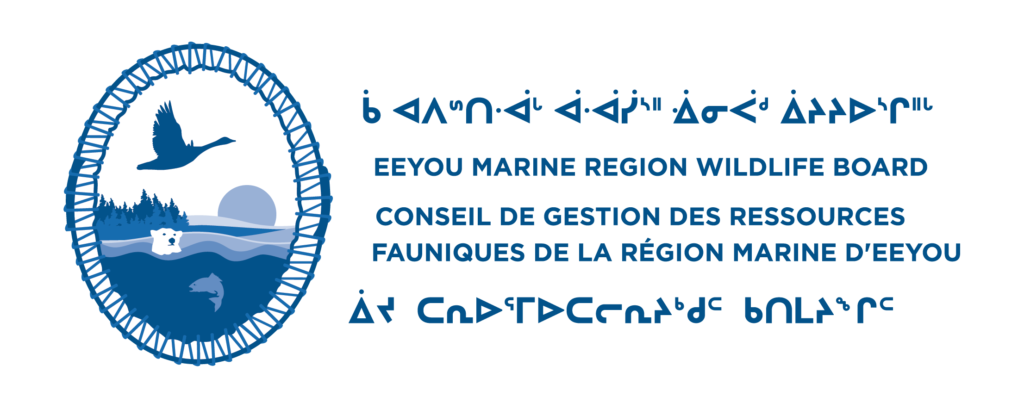Beluga Management
2020-2026 the Beluga Management System
The EMRWB and NMRWB share management responsibilities for the Eastern Hudson Bay beluga whale population. This includes approving 5-year management plans, the most recent plan spanning 2020-2026.
On January 21 -23, 2020 the WB’s held a public hearing in Kuujjuaraapik, Nunavik, where they were available to hear the information, concerns, and thoughts of all interested parties on the future of beluga management in Nunavik and the Eeyou-Istchee. Beluga is a very important species for the Nunavik Inuit. This marine mammal represents an important subsistence food source for all the Inuit communities in Nunavik, including Kuujjuaraapik and Umiujaq, who are included in the Inuit/Cree zone of the Overlap Area between the Eeyou Marine Region and the Nunavik Marine Region. Representatives from LNUK, RNUK, NMRWB, Makivik, DFO and the CNG attended the hearing, as well as numerous hunters and elders from all Inuit communities of Nunavik. This hearing is part of the process of developing a new Management Plan, as the previous one expired in February 2020. The hearing provided the decision-makers with an opportunity to gather evidence and hear views and experiences from all parties.
The NMRWB and the EMRWB submitted their initial Decision on beluga management to the Minister of Fisheries and Oceans (DFO) on May 27, 2020. The initial decision was rejected by the minister on July 23, 2020, which requested the WB’s to reconsider some aspects of their decision. The WB’s sent a revised final decision on September 28, 2020, and the minister accepted with variations on November 26, 2020. To view the October 2020 press release on the EMRWB and NMRWB process click here.
Some of the key decisions for the 2020-2026 Beluga Management System included:
- Starting on September 1st and ending on October 31st, the Hudson Strait area will be closed to protect the EHB stock during their fall migration.
- There is a TAT of 20 beluga within the Eastern Hudson Bay Arc Region.
- Hunting activities are prohibited in the Mucalic Estuary area, the Little Whale River Estuary, and the Nastapoka Estuary but may be opened on a case-by-case basis upon approval of an Estuary Harvesting plan.
- The LNUKs have the sole authority for developing Local Management and Hunt Plans for their community, which may include community bylaws.
- Harvesters must take all steps necessary to obtain biological samples from all beluga harvested.
On April 11-13, 2022 the WB’s and representatives from DFO, RNUK, and Makivik met in Montreal, QC for the first annual review of the 2020-2026 Beluga Management Plan. Overall, the meeting was productive and fostered discussion between all organizations about what worked in year one of the Beluga Management System, and what challenges were encountered. The WB’s agreed on a list of action items resulting from this meeting which can be found in the 2022 Beluga Management Annual Review Meeting Summary Report.
The second Beluga Management Annual Review Meeting took place in Kuujjuaraapik on March 30-31, 2023. The final report from this meeting, including a list of action items for 2023-24, can be accessed here.


Department of Fisheries and Oceans 2021 Beluga Aerial Survey
In July 2021, the Department of Fisheries and Oceans (DFO) performed a Beluga Aerial Survey over Eastern Hudson Bay and James Bay. DFO conduct this survey to calculate a new estimate of the number of belugas in the James Bay and Eastern Hudson Bay areas. They follow the same basic design that has been used during previous surveys (1985, 1993, 2001, 2004, 2008, 2011, 2015) with parallel lines being flown in an east-west direction to cover these two areas. The survey is performed in the summer to observe belugas that are in their summer feeding areas and records information including time and location of observations, group size, behaviour and number of young beluga, and general environmental conditions. This information is used to calculate the area surveyed, total number of animals observed, spatial distribution of animals, group size and density. The results from the 2021 survey will be analyzed during the fall/winter of 2021-22.
![]()


2015 Beluga Aerial Survey Results
The objective of the aerial survey was to estimate the abundance of beluga in James Bay and Eastern Hudson Bay to provide scientific advice. Surveys have occurred in a ~5-year cycle from 1985-2015, occurring from mid-July to the end of August. For the EHB population, the DFO population model estimates a starting population of 6,600 (95% CI=4,800-9,300) in 1974. The model indicates that the population declined from 1974 reaching a minimum of 3,100 in 2001 and since then has increased to a current population estimate of 3,400 (95% CI=2,200-5,000, all rounded to nearest 100). The current estimate for the James Bay population of beluga is 10,615 (95%CI: 6,559-17,178), 2.9x more abundant than the EHB population. A summary from the 2015 beluga survey can be found here.



